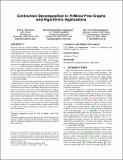| dc.contributor.author | Demaine, Erik D. | |
| dc.contributor.author | Hajiaghayi, Mohammad Taghi | |
| dc.contributor.author | Kawarabayashi, Ken-ichi | |
| dc.date.accessioned | 2012-10-10T17:27:14Z | |
| dc.date.available | 2012-10-10T17:27:14Z | |
| dc.date.issued | 2011-06 | |
| dc.identifier.isbn | 978-1-4503-0691-1 | |
| dc.identifier.uri | http://hdl.handle.net/1721.1/73855 | |
| dc.description.abstract | We prove that any graph excluding a fixed minor can have its edges partitioned into a desired number k of color classes such that contracting the edges in any one color class results in a graph of treewidth linear in k. This result is a natural finale to research in contraction decomposition, generalizing previous such decompositions for planar and bounded-genus graphs, and solving the main open problem in this area (posed at SODA 2007). Our decomposition can be computed in polynomial time, resulting in a general framework for approximation algorithms, particularly PTASs (with k ∼ 1/ε), and fixed-parameter algorithms, for problems closed under contractions in graphs excluding a fixed minor. For example, our approximation framework gives the first PTAS for TSP in weighted H-minor-free graphs, solving a decade-old open problem of Grohe; and gives another fixed-parameter algorithm for k-cut in H-minor-free graphs, which was an open problem of Downey et al. even for planar graphs.
To obtain our contraction decompositions, we develop new graph structure theory to realize virtual edges in the clique-sum decomposition by actual paths in the graph, enabling the use of the powerful Robertson--Seymour Graph Minor decomposition theorem in the context of edge contractions (without edge deletions). This requires careful construction of paths to avoid blowup in the number of required paths beyond 3. Along the way, we strengthen and simplify contraction decompositions for bounded-genus graphs, so that the partition is determined by a simple radial ball growth independent of handles, starting from a set of vertices instead of just one, as long as this set is tight in a certain sense. We show that this tightness property holds for a constant number of approximately shortest paths in the surface, introducing several new concepts such as dives and rainbows. | en_US |
| dc.language.iso | en_US | |
| dc.publisher | Association for Computing Machinery (ACM) | en_US |
| dc.relation.isversionof | http://dx.doi.org/10.1145/1993636.1993696 | en_US |
| dc.rights | Creative Commons Attribution-Noncommercial-Share Alike 3.0 | en_US |
| dc.rights.uri | http://creativecommons.org/licenses/by-nc-sa/3.0/ | en_US |
| dc.source | MIT web domain | en_US |
| dc.title | Contraction decomposition in h-minor-free graphs and algorithmic applications | en_US |
| dc.type | Article | en_US |
| dc.identifier.citation | Erik D. Demaine, MohammadTaghi Hajiaghayi, and Ken-ichi Kawarabayashi. 2011. Contraction decomposition in h-minor-free graphs and algorithmic applications. In Proceedings of the 43rd annual ACM symposium on Theory of computing (STOC '11). ACM, New York, NY, USA, 441-450. | en_US |
| dc.contributor.department | Massachusetts Institute of Technology. Computer Science and Artificial Intelligence Laboratory | en_US |
| dc.contributor.mitauthor | Demaine, Erik D. | |
| dc.relation.journal | Proceedings of the 43rd annual ACM symposium on Theory of computing (STOC '11 ) | en_US |
| dc.eprint.version | Author's final manuscript | en_US |
| dc.type.uri | http://purl.org/eprint/type/ConferencePaper | en_US |
| dspace.orderedauthors | Demaine, Erik D.; Hajiaghayi, MohammadTaghi; Kawarabayashi, Ken-ichi | en |
| dc.identifier.orcid | https://orcid.org/0000-0003-3803-5703 | |
| mit.license | OPEN_ACCESS_POLICY | en_US |
| mit.metadata.status | Complete | |
